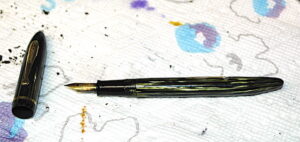Vintage fountain pens are not just writing instruments; they are pieces of history, craftsmanship, and elegance. For collectors and enthusiasts, owning a vintage fountain pen is akin to owning a piece of art. However, with age and use, these pens may require restoration to maintain their functionality and beauty. In this comprehensive guide, we’ll explore the signs that indicate your vintage fountain pen may need restoration, as well as the steps you can take to preserve its integrity.
Nib Issues
The nib is the heart of a fountain pen, responsible for delivering ink onto the paper. Signs of wear or damage to the nib can significantly impact the writing experience. Look for the following signs:
- Scratchiness: If the nib feels scratchy or rough on the paper, it may indicate misalignment or damage to the tipping material.
- Ink Flow Issues: Inconsistent ink flow, skipping, or excessive dryness can be signs of a clogged feed or damaged nib.
- Bent Nib: A bent nib can occur due to mishandling or accidental dropping of the pen, leading to poor performance and uneven writing.
Cracks and Discoloration
Vintage pens are often made from materials like celluloid, ebonite, or hard rubber, which can degrade over time. Cracks or discoloration in the pen body or cap are common indicators of aging:
- Cracks: Check the body and cap of the pen for hairline cracks or fractures, especially around the barrel threads or cap lip.
- Discoloration: Fading, yellowing, or browning of the material can be signs of oxidation or exposure to light and moisture.
Filling Mechanism Malfunctions
Many vintage fountain pens use intricate filling mechanisms such as lever fillers, piston fillers, or sac fillers. Problems with these mechanisms can affect the pen’s ability to hold and dispense ink:
- Sac Deterioration: Rubber sacs used in sac fillers can deteriorate over time, leading to leaks or ink seepage.
- Corroded Parts: Metal components of filling mechanisms can corrode or rust, hindering their operation.
- Stiffness or Resistance: Difficulty in operating the filling mechanism, such as a stiff lever or tight piston, may indicate the need for lubrication or replacement of parts.
Cap and Clip Issues
The cap and clip of a vintage fountain pen serve both functional and aesthetic purposes. Pay attention to the following issues:
- Loose Cap: A loose cap that doesn’t securely fasten onto the pen can result in ink evaporation and drying out of the nib.
- Clip Misalignment: A misaligned or loose clip can scratch the pen body or cause damage when attaching it to a pocket or notebook.
- Rust or Corrosion: Metal clips or bands on the cap can corrode over time, affecting their appearance and functionality.
Odor and Residue
Unpleasant odors or residue inside the pen can indicate mold, ink buildup, or deterioration of internal components:
- Moldy Smell: A musty or moldy odor may suggest the presence of mold or mildew inside the pen, often due to ink residue or improper storage.
- Ink Residue: Excessive ink buildup inside the pen can clog the feed and affect ink flow, leading to messy writing and staining.
General Wear and Tear
Inspect the overall condition of the pen for signs of wear and tear:
- Scratches and Scuffs: Surface scratches or scuffs on the pen body or cap are common with regular use but can detract from its aesthetic appeal.
- Engraving Fading: Engraved or embossed markings on the pen may fade over time, diminishing its historical or sentimental value.
Conclusion
Vintage fountain pens are cherished possessions that require proper vintage fountain pen restoration to preserve their beauty and functionality. By being vigilant for signs of wear and addressing them promptly, you can ensure that your vintage fountain pen remains a cherished heirloom for generations to come. Whether it’s restoring the nib, repairing cracks, or servicing the filling mechanism, entrusting your pen to a skilled pen restorer can breathe new life into your treasured writing instrument. Remember, with proper care and attention, your vintage fountain pen will continue to inspire and delight for years to come.
